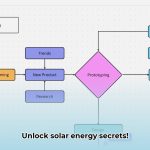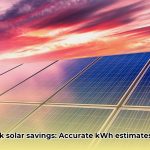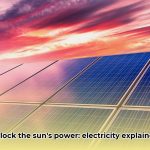Is Sunlight Right for You? Evaluating Your Home’s Solar Potential
Considering solar? Fantastic! But first, let’s assess your home’s suitability. A south-facing roof, sloped between 15 and 40 degrees, is ideal for capturing sunlight. However, east- and west-facing roofs can still be viable, potentially producing slightly less energy. Shade from trees or buildings can significantly impact energy generation, and your roof must be structurally sound to handle the added weight of panels. Online tools, like the NREL’s solar potential estimator, provide a preliminary assessment based on your location, roof angle, and shading. A local solar installer can offer a personalized evaluation.
Sizing Your System & Choosing the Right Equipment
Choosing the right solar system size depends on your electricity consumption. Review your energy bills for usage patterns. Then, consider:
- Solar Panels: Wattage and efficiency ratings vary. Higher wattage means more power, while higher efficiency indicates better sunlight conversion.
- Inverters: These convert DC electricity from panels to usable AC. The inverter size must match your system’s output.
- Batteries (Optional): If desired, research battery capacity and desired backup power duration. Many types exist, each with its own characteristics.
Permits, Inspections, and Installation
Before installation, ensure your system meets local codes and safety standards through permits and inspections. A qualified installer can guide you through this process. While DIY installation might be tempting, it’s complex and potentially hazardous. For optimal performance and safety, hiring a NABCEP-certified professional is recommended.
Financing Your Solar Journey
Going solar offers financial advantages:
- Federal Investment Tax Credit (ITC): This credit can significantly reduce your federal tax liability. Stay updated on potential changes to this credit as legislation evolves.
- State & Local Incentives: Explore potential rebates, tax credits, property tax exemptions, and SRECs in your area. Utility companies may also offer rebates.
- Loans: Secured or unsecured loans provide system ownership with monthly payments. Understand loan terms and interest rates.
- Leases: Rent solar panels with a fixed monthly fee, lowering the initial investment. However, you won’t own the system or be eligible for certain incentives.
- Power Purchase Agreements (PPAs): A third-party owns and maintains the system; you pay for the generated electricity. Compare PPA rates with current electricity costs.
Beware of scams. Research reputable companies and review offers carefully. The joint statement by the Treasury, CFPB, and FTC (August 7, 2024) provides guidance on avoiding predatory lending practices.
Maintaining Your Solar Investment and Net Metering
Solar panels require minimal maintenance—occasional cleaning and periodic inspections suffice. Monitor system performance through apps or online portals for early issue detection. Net metering allows you to sell excess generated energy back to the grid, acting as a credit with your utility company. Policies vary by location, so understand your local rules.
Solar Plus Storage: Enhancing Energy Independence
Battery storage adds resilience, storing excess energy for later use. This increases energy independence during outages, reduces peak-hour electricity reliance, and provides greater control over your energy usage.
Home Value and HOAs
Solar panels may increase property value, but check your HOA’s guidelines for potential restrictions on appearance and placement.
How Solar Panels Work: Capturing the Sun’s Energy
Solar panels function as mini power plants, utilizing the photovoltaic effect—”light-electricity”—to convert sunlight into usable power. Photons from sunlight interact with silicon layers within the panels, dislodging electrons and creating an electrical current.
A solar cell, the panel’s building block, consists of negatively and positively charged silicon layers, forming a P-N junction that directs electron flow, creating a direct current (DC). Multiple cells interconnected within a frame comprise a solar panel, and multiple panels form a solar array.
Key system components include:
- Solar Panels: Convert sunlight to DC electricity.
- Inverter: Converts DC to AC electricity for home use.
- Wiring & Connectors: Carry current between components.
- Mounting System: Secures panels.
- Battery Storage (Optional): Stores excess energy.
- Charge Controller (Optional): Regulates battery charging.
Excess energy can be sold back to the grid through net metering.
Types of Solar Panels
- Monocrystalline: Highly efficient (18-22%) but more expensive.
- Polycrystalline: Moderately efficient (15-17%) and more affordable.
- Thin-Film: Flexible and lightweight, lower efficiency (11-13%), potentially lower installation costs, and promising for future development.
Solar Costs: A Detailed Breakdown
Solar costs depend on system size, location, installer, and several other factors:
- Panel Cost: Varies based on type, brand, and wattage.
- Installation Costs: Labor, wiring, mounting hardware.
- Inverter Costs: DC to AC conversion.
- Permitting & Inspection Fees: Varies by location.
- Balance of System (BOS) Costs: Wiring, conduit, mounting racks.
Typical costs (per watt): Installation ($0.50-$1.50), Inverter ($0.40-$0.90), BOS ($0.60-$1.00).
Solar ROI: Factors to Consider
ROI depends on system size, energy consumption, sunlight availability, and local incentives. Ongoing advancements like Perovskite solar cells suggest future efficiency improvements and cost reductions. Consult a qualified installer for a personalized assessment.
The Future of Solar: A Bright Outlook
Solar energy’s future is promising. Ongoing research and development aim to improve efficiency and affordability. Solar is becoming integral to energy independence and a more resilient power grid. Community solar projects expand clean energy access. Ready to harness the power of the sun? Contact a local installer for a personalized consultation today!
- How To Make Electricity At Home With Water Using DIY Micro-Hydro - December 7, 2025
- How to Generate Electricity from Water at Home for Off-Grid Power - December 6, 2025
- Small Scale Hydropower Brings Sustainable Energy to Rural Areas - December 5, 2025
















